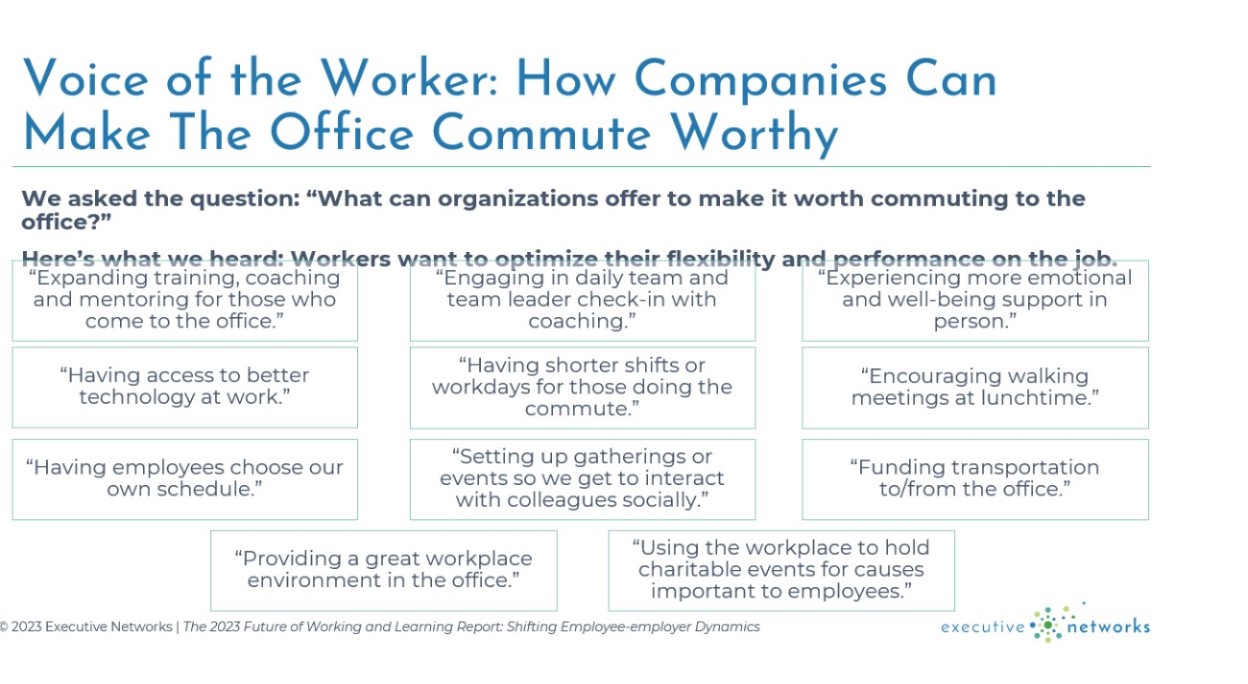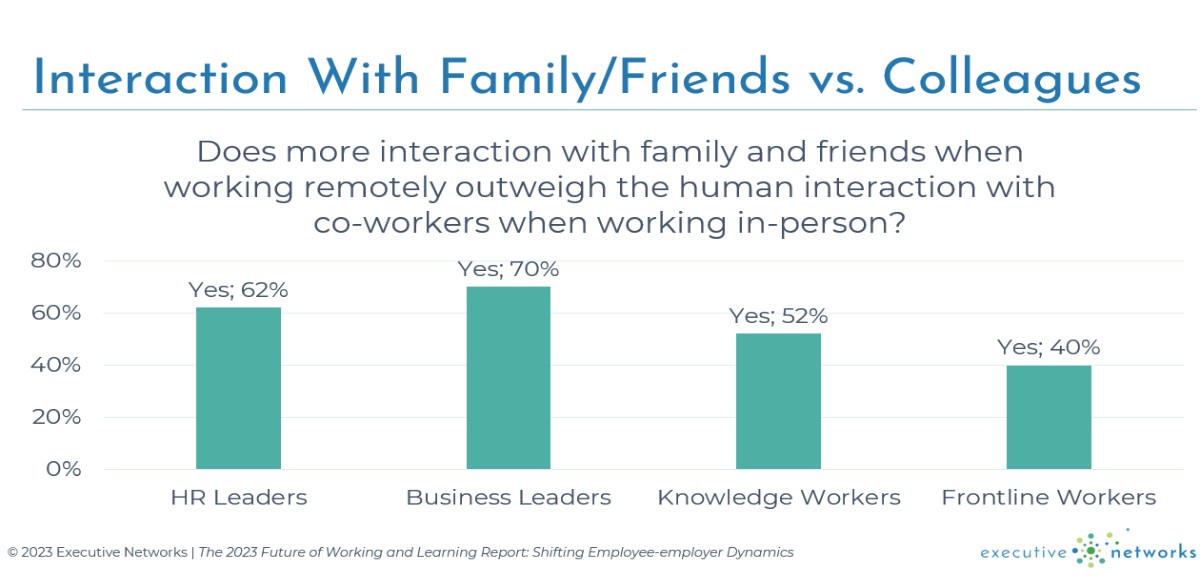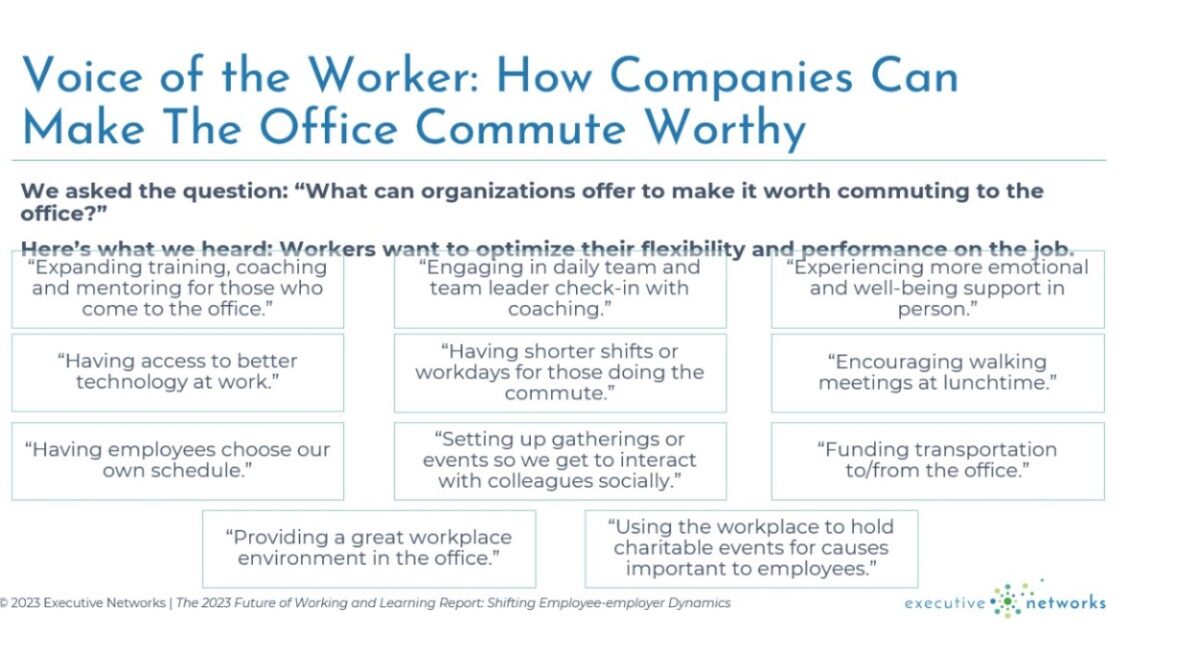Despite corporate America’s efforts to create inclusive work environments, leaders across the globe say proximity bias is likely real, according to a 2023 Future of Working and Learning Report released Thursday.
When it comes to an in-person versus remote-hybrid workforce, 71% of senior HR leaders and 62% of senior business leaders agree or strongly agree that in-person workers probably benefit from a proximity bias, states the report by HR research and leadership organization Executive Networks, which surveyed more than 1,300 HR leaders, business leaders, knowledge workers and frontline workers across the globe.
Proximity bias is when managers and executives look more favorably upon in-person workers than those who work remotely. It bias stems from the notion that workers whom they can physically see are more productive than those they can’t, despite studies that show productivity among remote workers is higher than their counterparts in offices. For leaders, part of the problem may lie in the out-of-sight, out-of-mind issue when assigning tasks, resulting in remote workers potentially finding they are promoted less than in-person employees. This bias may be at play in companies increasingly calling workers back to the office—despite employees’ objections.
“At the end of the day, hybrid and remote working must be an inclusivity issue. It must be inclusive for all types of workers,” says Jeanne Meister, executive vice president of Executive Networks.
For remote and hybrid workers, concerns about a lack of inclusivity and career advancement have been ongoing since the start of the pandemic. And the survey results may bring an element of confirmation to those concerns.
To dive deeper into flexible work strategies, join HRE from May 3-5 for the annual Health & Benefits Leadership Conference in Las Vegas. Learn more here.
“As HR leaders, we have an obligation to look at proximity bias and [say], ‘What can we do about it?’,” Meister says, noting remote and hybrid work is here to stay.
Related: Quiet quitting: Why it’s exactly what should be happening today
Ironically, though, more employees are heading back into the office these days, as an increasing number of companies institute return policies. These policies often call for working in the office three days a week, and even four days may be looming.
To entice employees back, companies are laying out everything from catered lunches to fun-filled activities. But, here’s a sobering statistic: Only 28% of knowledge workers say their company knows how to make it worthwhile for them to come into the office, according to the survey.
HR needs to walk a delicate balance to bring employees back. One survey notes 58% of workers say they would seek another job if working remotely was no longer an option. And despite some industry sectors like tech that have had widespread layoffs, the overall labor market is tight with a historically low 3.4% unemployment rate.
How employers can attract workers back into the office
Companies need to adopt a purposeful and “commute-worthy” mindset when developing return-to-office plans, says Meister.
“Workers say their company is not doing anything to make coming into the office commute-worthy,” says Meister.
Employers should consider offering a shorter work week to employees who come into the office to compensate them for lost time spent on commuting or offer a stipend to offset the costs of gasoline, bridge tolls, public transportation or other transportation costs, Meister says, recapping some employee comments that surfaced in the survey.
Additionally, a desire to receive more in-person time with colleagues and more opportunities for in-person networking, mentoring, training and daily check-ins with their team were common threads from survey respondents, Meister says.
For example, creating an off-site work vibe at the office by providing ample time for employees to network and get to know each other in a fun environment can help draw them in, she adds.

The actions listed above can help tip the scales in an employer’s favor to entice workers into the office. But currently, the majority of knowledge workers, business leaders and HR leaders say the benefits of spending more time with family members and friends in a remote work environment outweigh the time spent with team members and colleagues in the office, the survey found.

Not as many frontline workers favor the benefits of family time over in-person connections at work, but this group does want more flexibility in selecting a schedule that meets their needs and believes it will lead to better productivity and performance.
Related: Employee anxiety about returning to the office is sky-high. Now what?
Strategizing for a return-to-office
One of the most important questions to answer before announcing a new hybrid work environment or an increase in the number of in-office days is why it is needed, Meister says.
“There needs to be much clearer communication on the ‘why’ behind coming into the office,” she said. “For the last three years, nine out of 10 knowledge workers have had the flexibility of working remotely or hybrid. So, they’re asking why the office still matters.”
HR leaders also need to address what a successful hybrid work environment looks like, such as, when employees should come into the office and which roles should be in the office part of the time, in the office full-time or fully remote, for example.
It turns out there is a disconnect in providing that guidance. According to the survey, 71% of HR leaders say their organizations have guidelines on how to successfully work in a hybrid environment, yet only 29% of knowledge workers and 35% of frontline workers say they know of such guidelines.
“If those policies and guidelines exist, HR leaders are doing an inadequate job communicating the why and how behind those guidelines,” Meister said.
Other questions HR leaders should ask themselves, include:
- How can organizations both optimize flexibility and performance?
- How are employee needs listened to regarding returning to the office?
- Are frontline managers equipped to have meaningful discussions about flexibility and performance with their teams?
And, perhaps, the biggest question of all may be how to eliminate proximity bias for those who remain remote or hybrid workers, rather than taking advantage of your company’s return-to-office efforts.
A focus on eliminating proximity bias, however, may be trumped by a focus on return-to-the office. Says Meister, “Our research found that, yes, there is proximity bias and there’s a much greater percentage of business leaders than we thought who are saying proximity matters.”
The post Proximity matters at work. What does that mean for the future of remote work? appeared first on HR Executive.
